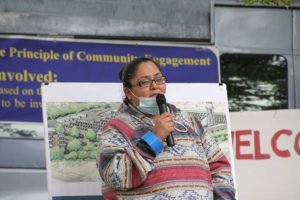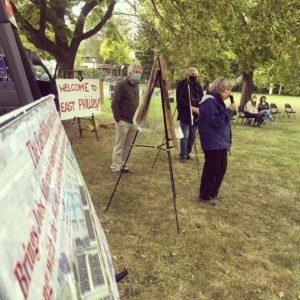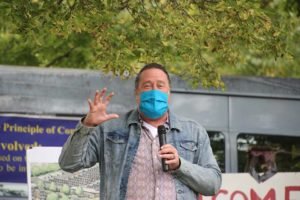 There are some nights in Cedar Field Park that "there's a fog in the air we don't know where it came from," said Little Earth resident Jolene Jones, who supports the urban farm, green housing and jobs proposal by EPNI. (Photo by Tesha M. Christensen)
There are some nights in Cedar Field Park that "there's a fog in the air we don't know where it came from," said Little Earth resident Jolene Jones, who supports the urban farm, green housing and jobs proposal by EPNI. (Photo by Tesha M. Christensen)Southside residents could have had access to fresh, locally grown food this summer after other grocery stores were damaged in the civil unrest.
Instead, the area is a food desert.
They could have had space to relocate their businesses after their existing locations were burned and vandalized.
Instead, some are moving permanently out of the area.
They could have had a place to live at super affordable rates – one with jobs available within the same building.
Instead, there are hundreds of tents on vacant lots and in parks occupied by people who can’t afford a place to rent.
These issues were pieces of the plan for the East Phillips Indoor Urban Farm along the Midtown Greenway that was created in 2014 by community members who knew what their needs were long before things reached a breaking point this summer.
Instead, the city threatened eminent domain and purchased land the East Phillips Neighborhood Institute was negotiating to buy at 26th and Longfellow Ave. which blocked their ability to reinvent an area known as the “arsenic triangle.”
 Sara Chars of Global Shapers
Sara Chars of Global ShapersOrganizers talked about issues and their proposed solutions during an environmental justice event at Cedar Field on Sept. 19, 2020. The event was organized with Global Shapers, a United Nations World Economic Development Forum with chapters around the world, in partnership with East Phillips Neighborhood Institute (EPNI), and Little Earth of United Tribes.
Two different plans
The East Phillips Indoor Urban Farm project would repurpose the existing 230,000 former Sears warehouse built in 1947 and prevent the pollution-producing demolition the city has planned.
The farm at the 7-6-acre site would produce organic produce, including aquaponic grown fish. It would provide very affordable family housing along with free housing for homeless with the promise of food, jobs and safety. The project would also include one of the largest solar arrays in the state on the roof; a world café, coffee shop and food market with a gallery to display and sell neighborhood artisans’ works all run by local youth; a bike shop on the Midtown Greenway; and space for many of the burned out Lake St. businesses resulting from the murder of George Floyd.
The project meets every goal of the South Side Green Zone and is in the South Minneapolis Opportunity Zone. It is also supported by the wide range of diverse organizations in the neighborhood that is 83% people of color (see editorial on page 4 for a list of some of the supporters). Over 500 people have signed a petition in support of the indoor urban farm.
The city’s plan is to demolish the iconic Sears warehouse, which will release arsenic in the air that is currently encapsulated. It would be replaced by a series of sheds for 400 commercial city vehicles (most of them diesel), a hot asphalt storage facility, and multi-story parking ramp for the 400 employee vehicles that would be coming and going twice a day. They would also store manhole covers, sewer pipes, and sand-salt mix. No water would be treated on the site; that is done at 4500 Reservoir Blvd. in Columbia Heights.
The city’s current water maintenance facility, known as the East Water Yard, is located on 2.4 acres in Ward 3 at Hennepin Ave. E. and 5th Ave. N. It dates back 120 years and is the hub for maintaining the city’s 1,000 miles of water mains, 16,000 valves, and street holes, and 8,000 hydrants.
Ward 1 Council Member Jeremiah Ellison has asked to have the water yard located there, but the city has not adjusted its project.
“This plan is scary as hell. I’m afraid for everybody here,” said Cassandra Holmes, who resides at Little Earth of the United Tribes Community, the largest urban Native American population in the United States.
“For me, it’s another form of genocide.”
 Cassandra Holmes
Cassandra HolmesKids with asthma, heart
problems and more
This low-income neighborhood has one of the highest levels of asthma and arsenic poisoning in children in the state. According to the Minnesota Department of Health data, over 200 of every 10,000 people in the area (south Minneapolis from downtown on the north to Minnehaha Ave. on the south) are hospitalized for an asthma attack every year.
Area residents also suffer from arsenic poisoning at a higher rate than anywhere else in Minneapolis except for North Minneapolis. Much of that can be traced to an open air arsenic storage by the CMC Heartland Partners Lite Yard on the north side of 28th St. (now occupied by Smiley’s Family Medicine Clinic).
These statistics are more than dots on a chart for Holmes. “I have a son I lost to heart disease. He just got it at 14,” she said. He died in 2013 at age 16.
“I’ve got another son who is experiencing heart problems.”
Two others in the community have recently died from heart problems they weren’t born with. There are many more that are living with heart problems.
“We have so many kids who don’t go to school because of their asthma problems,” added Holmes.
Longtime local resident and former city council member Robert Lilligren said he takes three different types of medication so he can breath.
Fifty-year neighborhood resident Brad Pass raised two kids along 18th Ave., and one needed open heart surgery in his early 40s. “We’ve got to stop this,” said Pass.
“We’re trying to teach our kids how to be green so they can survive,” observed Jolene Jones, who works for the Little Earth Residents Association (LERA). When they started a garden on the three acres that abut the Hiawatha wall, the arsenic levels in the soil were so high they had to do raised beds.
There are some nights in Cedar Field Park that “there’s a fog in the air we don’t know where it came from,” said Jones.
Stinky air often drifts over from Smith Foundry and Bituminous Roadways hot asphalt mix plants at Cedar and 24th. This same pollution falls on the football field of South High School, a few blocks south of the area, the larger Corcoran neighborhood, Seward Neighborhood, and others downwind.
Little Earth is home to over 500 kids, and that number swells to 1,000 in the summer. Over half are under age 10, according to Jones.
The residents of Little Earth have to fight for anything they get, she said. Twenty years ago, they asked for a stoplight on Cedar to help people safely crossing from one side of the neighborhood to the other. Nothing happened until a couple years ago. It took three days in a row where folks blocked the street before the city agreed to install a $15,900 stoplight.
 Karen Clark talks about the indoor urban farm project.
Karen Clark talks about the indoor urban farm project.EPNI sues city
The city’s Hiawatha Expansion project would put additional pollution into an area that already has high levels.
That amount of pollution is not allowable in the area, according to longtime resident and former State Representative Karen Clark, who co-wrote the Clark-Berglund Environmental Justice Law that was enacted by the state legislature in 2008 (MN Statute 116.07 subd 4a). It requires that any project in this neighborhood be reviewed by the Minnesota Pollution Control Agency to analyze the cumulative pollution effects — not only what will be caused by the new or expanded project.
Over the years, the law has been applied to projects by the Metropolitan Council, city of Minneapolis, and Abbott Northwestern Hospital, among others.
Because the city has refused to submit to an outside review, EPNI is suing.
“The Hiawatha Expansion Project is likely to cause pollution in an already polluted neighborhood and will likely be detrimental to the public health, safety, and welfare of those living in the East Phillips neighborhood,” according to the suit, and it would disproportionately harm the health of people of color.
The group is asking a judge to stop work on the project and order the city to complete an environmental assessment and environmental impact statement.
“We have never been able to take advantage of the city’s number one core value of community engagement,” stated Pass. Instead, the city has refused to let community members speak at council meetings. After the Community Environmental Advisory Committee (CEAC) and Southside Green Zone Advisory Committee came out in support of the EPNI plan, City Clerk Joe Carl sent letters to both on July 30 threatening to unappoint the members of the group or even to disband them.
 Robert Lillegren
Robert LillegrenHow to get involved and show support
Lilligren passed three homeless encampments on his way to the Sept. 19 meeting. As the city considers indoor villages to house homeless, Lilligren supports the indoor urban farm plan, which could house people indoors almost immediately. “Here is a ready-made solution,” he said. “It’s a ready-made site. It could happen tomorrow.”
He and other speakers urged attendees to talk to their city council members about this effort. “It’s time for us to rise up,” Lilligren stated.
“We probably need to get ourselves in good trouble,” said architect and EPNI member Dean Dovolis of DJR Architecture.
“Voting is our voice,” said Jones. “Make voting a tradition.”
More at www.epnifarm.org.
Global Shapers Community is a network of young people working together to address local, regional, and global challenges. Globally, there are over 8,500 members in 400 city-based hubs in over 150 countries. Global Shapers Minneapolis-St. Paul Hub has about 30 members right now. Shapers believe in a world where young people are central to solution building, policy-making and systems change. Shapers state that "we are a bridge between those whose voices are powerful and those whose voices are under-represented." Joe Vital, an East Phillips community member committed to fighting back, said during the brainstorming, "This IS the Green New Deal." ~ Click here to read the Messenger interview with the Global Shapers.
Comments
No comments on this item Please log in to comment by clicking here